
The tennis world, a realm of constant analysis and unwavering opinions, has recently witnessed a sharp critique directed towards Iga Swiatek, the current world number one. A revered figure from the sport’s storied past, known for their incisive observations and unwavering honesty, has focused their attention on a specific aspect of Swiatek’s game: her serve.
“It’s a weakness,” the former slam legend declared, their words echoing through the tennis community. This wasn’t a casual observation but a pointed assessment, highlighting a potential vulnerability in the otherwise formidable armor of the Polish star. The serve, often considered the foundation of a player’s game, was being scrutinized with a level of intensity reserved for the very best.
The critique wasn’t merely a dismissal of the serve’s effectiveness; it delved into the technical nuances that could be hindering Swiatek’s performance. “The toss is inconsistent,” the legend elaborated, pinpointing a specific element that could be contributing to the perceived weakness. A fluctuating toss can lead to timing issues and a lack of rhythm, ultimately impacting the accuracy and power of the serve.
Furthermore, the analysis extended to the overall mechanics of the serve, suggesting that there was room for improvement in the fluidity and efficiency of the motion. “She’s not getting enough leverage,” they stated, implying a need for greater utilization of body weight and rotational force to generate more power. The serve, in their view, was not reaching its full potential, potentially leaving Swiatek vulnerable against opponents who excel in returning serves.
The discussion also touched upon the strategic implications of a less-than-dominant serve. “It puts her under pressure,” the legend asserted, highlighting the ripple effect that a weak serve can have on the rest of a player’s game. If an opponent can consistently attack the serve, it forces the server to play defensively from the outset, limiting their ability to dictate points and control the match’s tempo.
The critique wasn’t intended to be destructive but rather constructive, aimed at identifying areas for potential growth and improvement. “She’s a great player,” the legend acknowledged, emphasizing that the focus was on refining an already impressive game. The goal was to elevate Swiatek’s serve to a level that matched her other formidable weapons.
The narrative also addressed the importance of addressing weaknesses at the highest level of the sport. “At this level, everyone is looking for an edge,” they explained, underscoring the relentless pursuit of perfection that characterizes elite tennis. In a sport where margins are razor-thin, even the slightest imperfection can be exploited by opponents.
The discussion also delved into the psychological aspect of serving. “Confidence is key,” they noted, suggesting that any perceived weakness in the serve could impact Swiatek’s mental approach to the game. The ability to serve with conviction and belief is essential for maintaining composure under pressure.
The analysis wasn’t just a critique of a single serve; it was a broader commentary on the relentless pursuit of excellence that defines the top echelons of professional tennis. It’s a reminder that even the most dominant players are constantly seeking ways to improve, and that even a seemingly minor flaw can become a focal point of intense scrutiny. The narrative painted a picture of a champion facing the constant challenges of perfecting her craft, with the eyes of the tennis world watching.
Leave a Reply